If you’re reading this, something is most definitely wrong with you. You made it through my 4,000 word Part One of this article series and decided to come back for more. I’m not yet sure exactly how many parts this series will have, but if you read them all you’ll get insight into the way I attack best ball in many different tournament structures and entirely unique games (like Weekly Winners, the Eliminator, and TE Premium FFPC). That’s enough preamble—let’s pick up where we left off and dive in to how I played the WR position on DraftKings:
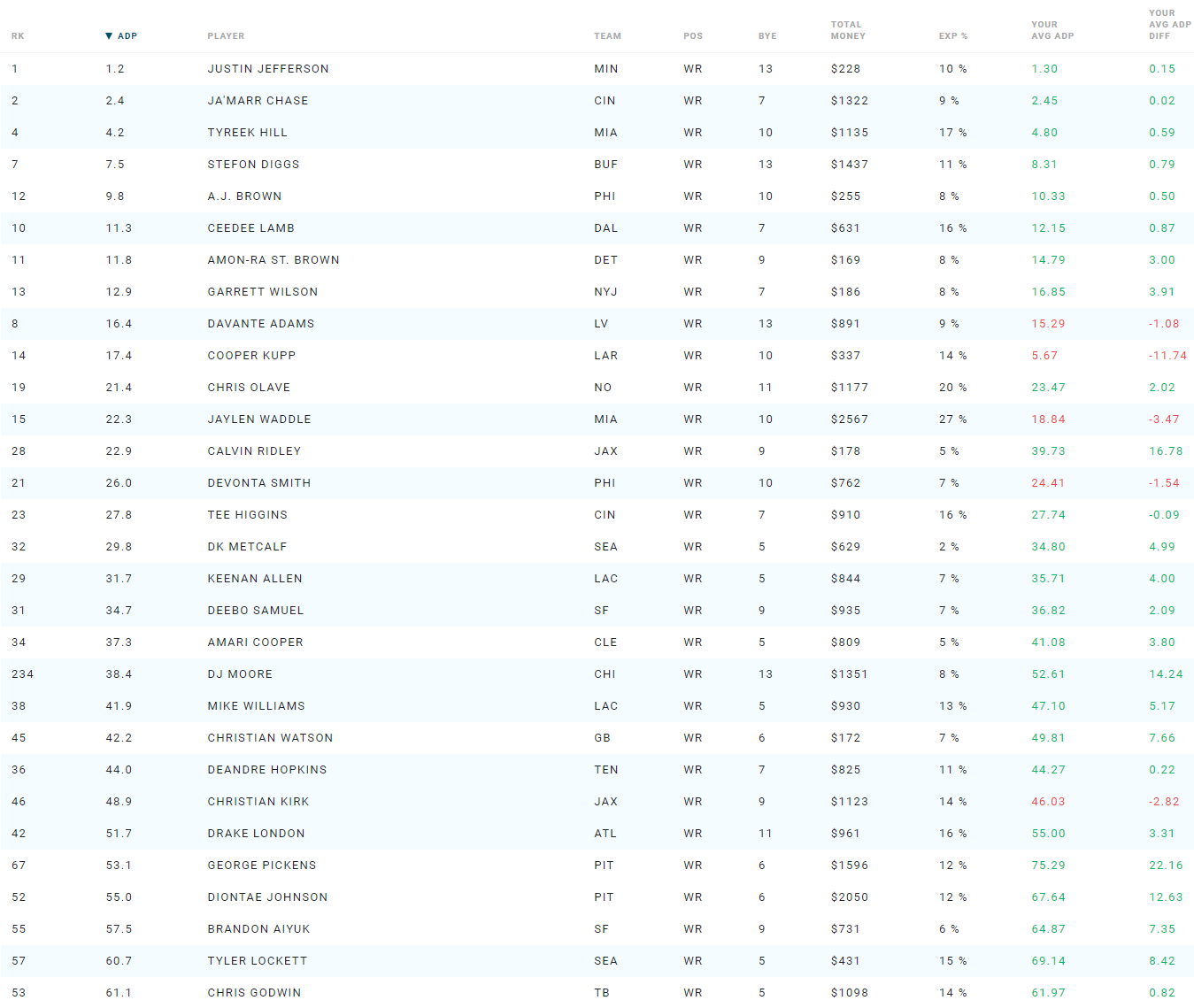
I’m going to tackle the exposure dump a little differently in this part compared to Part One. I wanted to provide all of my exposures for a position group together before writing about them, because there are definitely trickle-down effects as to who I draft later based on who I drafted early. However, I think the “wall of exposures” is a little daunting to consume, so I’ll be breaking it up into chunks for Part Two.
This first group of WRs contains my sixth highest overall player exposure on DraftKings in Jaylen Waddle. It is extremely unusual for me to have such a huge overweight position on a player going so early in drafts. In general, I want to be relatively flat in my exposures in the first couple rounds. This is because I more or less respect the market’s ability to identify the best players each year, which is consistent with what I found when creating my draft capital model that I referenced in Part One. Later in drafts I’m much more willing to deviate from the market on a player where I believe I have an information or analysis advantage. I also try not to follow strict rules or guidelines like “never over 20% on a player going in the first two rounds,” because I feel like that’s a way to box yourself out of the best option in individual drafts based on a macro portfolio management decision.
While I’m very cognizant of balancing my exposures to an extent to mitigate the individual player risk on my portfolio, I think we’re missing the point if we pass on the best option available in a draft to make a much worse pick for “risk management” purposes. Oftentimes in drafts I was making the decision between Waddle, the elite QBs, Olave, Pollard, Saquon, and—near the end of draft season (when Waddle fell because he had a “Questionable” tag)—Higgins and Smith. The only players in that group that I thought were close to Waddle were Pollard and Olave, and I strongly preferred Waddle to Olave based on the offense and the QB stack.
An area of the early WRs where I wish I had played it a little better is having slightly less Lamb exposure. I am perfectly happy to be overweight, but double the field is a bit much, especially when you consider that I was often passing on ARSB for him. I believe I let my priors on ARSB bias me too much. I like him as a player, I just preferred Garrett Wilson and Jaylen Waddle to him. I don’t think my assessment of his value relative to that group of four WRs (Lamb>Waddle>Wilson>ARSB) is too unreasonable, but I should have had more respect for the market here and flattened my Lamb exposure out a bit more to give a little to ARSB and Wilson.
My Cooper Kupp and Tyreek Hill exposures both got to very high numbers, especially for the way I like to play the early rounds. Both of these players were falling at certain points during the offseason (I was virtually done drafting by the time we got the Kupp hamstring injury reaggravation news). I viewed the top 4 WRs as all being relatively close, and so the fact that I could occasionally get Kupp and Hill in the mid to late first round meant I was going to be packing my bags. To tell you the truth, if Chase and Hill were going a couple picks later and with more variation in their ADP, I likely would have been taking Hill over Chase at some frequency. As it stood, Chase rarely fell beyond the third overall pick, so I never really passed on Jefferson or Chase when presented with the opportunity because I didn’t want to come in underweight on either player. There was a point in the draft season when I was over 20% Tyreek Hill and I decided to course-correct and balance him out with a little more Kupp. With the hindsight of week 1, my knee jerk overreaction is “Maybe I should have just gotten to 25% Hill.”
“Why did you come in underweight on Ridley? He smashed week 1, you donkey!” Look at my price on the 5% Ridley that I did get. My Ridley teams will be among some of the strongest Ridley teams in their respective tournaments, where I was able to get combos of Ridley with third round players that simply weren’t possible for those drafters who chased him up the board, like this one:
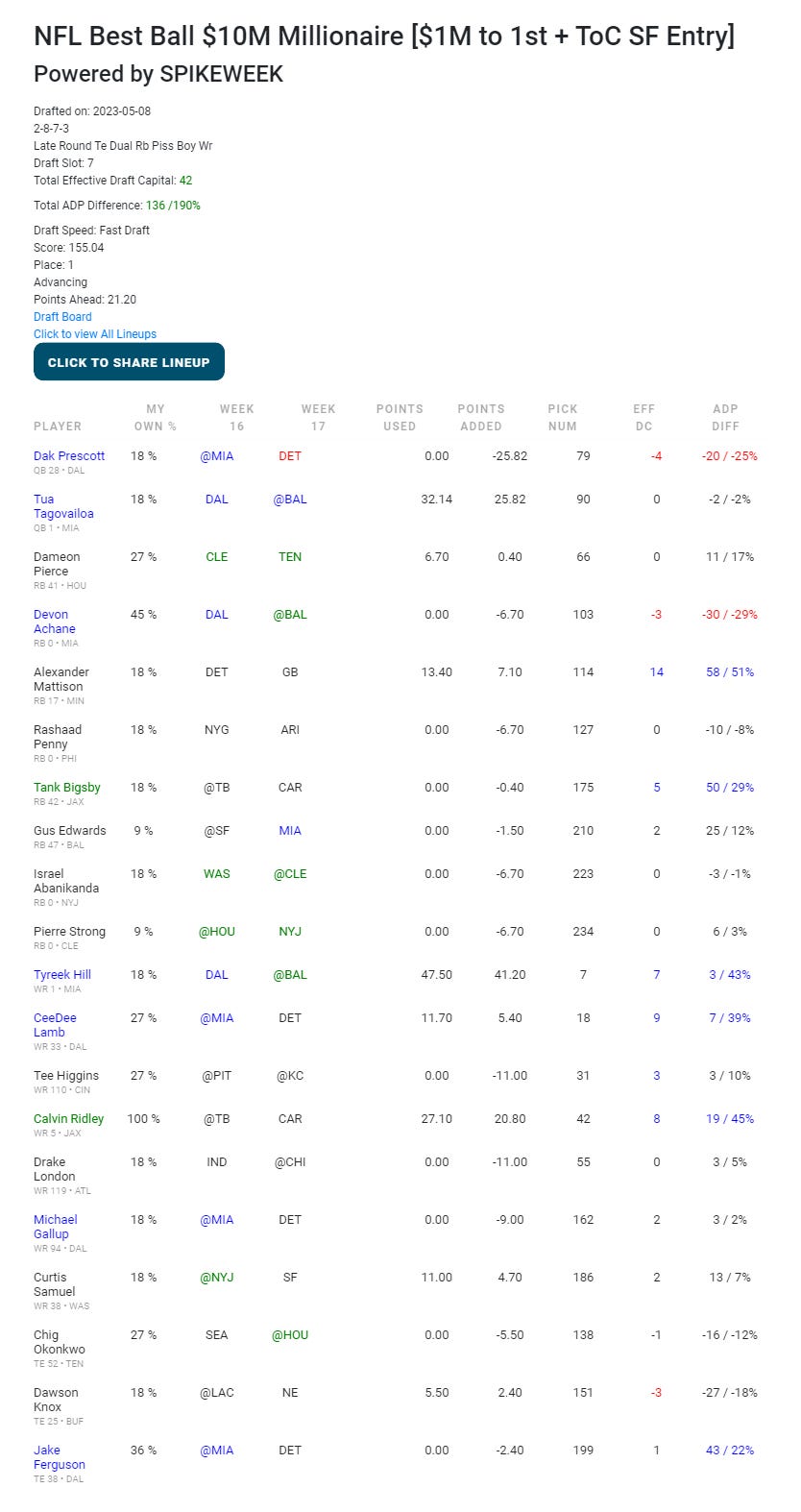
With the hindsight of week 1, do I wish I had more Ridley? Sure. I just didn’t have the confidence that he would be the dominant WR1 in that offense that would be necessary to pay off his rapidly rising price, so I abstained from chasing him up the board. The funniest thing to me is that I am pretty sure my read on the Jags offense was correct. I thought all three of Ridley, Kirk, and Jones would have their spike weeks, but we wouldn’t get a consistent bona fide stud WR1 from that team.
With only week 1 as a data point it’s hard to know for sure if Ridley consistently produces at this level week after week, or if he’s more of a quality spike week player. If I believed my own thesis, the correct way to play the offense is to take some of each player, with my exposure having an inverse relationship to the cost. Ideally I’d have something like 8% Ridley, 12% Kirk, and 20% Zay Jones. Unfortunately I came in with only 5% Ridley, 14% Kirk, and 11% Jones.
I think a big reason for my exposures being less than perfect for this offense is that I let my rankings auto pilot my decision to click Christian Kirk a little too much. I use weighted aggregate rankings from analysts that I trust, but one of those sources was pretty high on Kirk and it came through in my aggregate rankings. That part of the draft was often a big tier break, for both RBs and WRs. I’d often be left deciding between Kirk and Justin Herbert, Aaron Jones, Najee Harris, Drake London or Kenneth Walker. I often opted for Kirk, London, and Walker over the other options. In hindsight, I should have taken more naked Justin Herbert with plans of back stacking him, because I ended up with less Herbert than I’d like, but ultimately I think his price was efficient, so I don’t feel like I missed out on a huge value by often passing on him at ADP.
I guess my biggest takeaway here is that I need to trust the market less as we get out of the first few rounds, especially in these really wide tiers, and be willing to occasionally grab a player that may be a bit of a reach, purely for the sake of portfolio balance when I don’t have a high degree of confidence that the player is the best pick available. This is different than how I felt about my overweight Waddle position, where I felt confident that when I was selecting Waddle multiple teams ahead of me had made a mistake (and a big one at that) in passing on him for inferior picks.
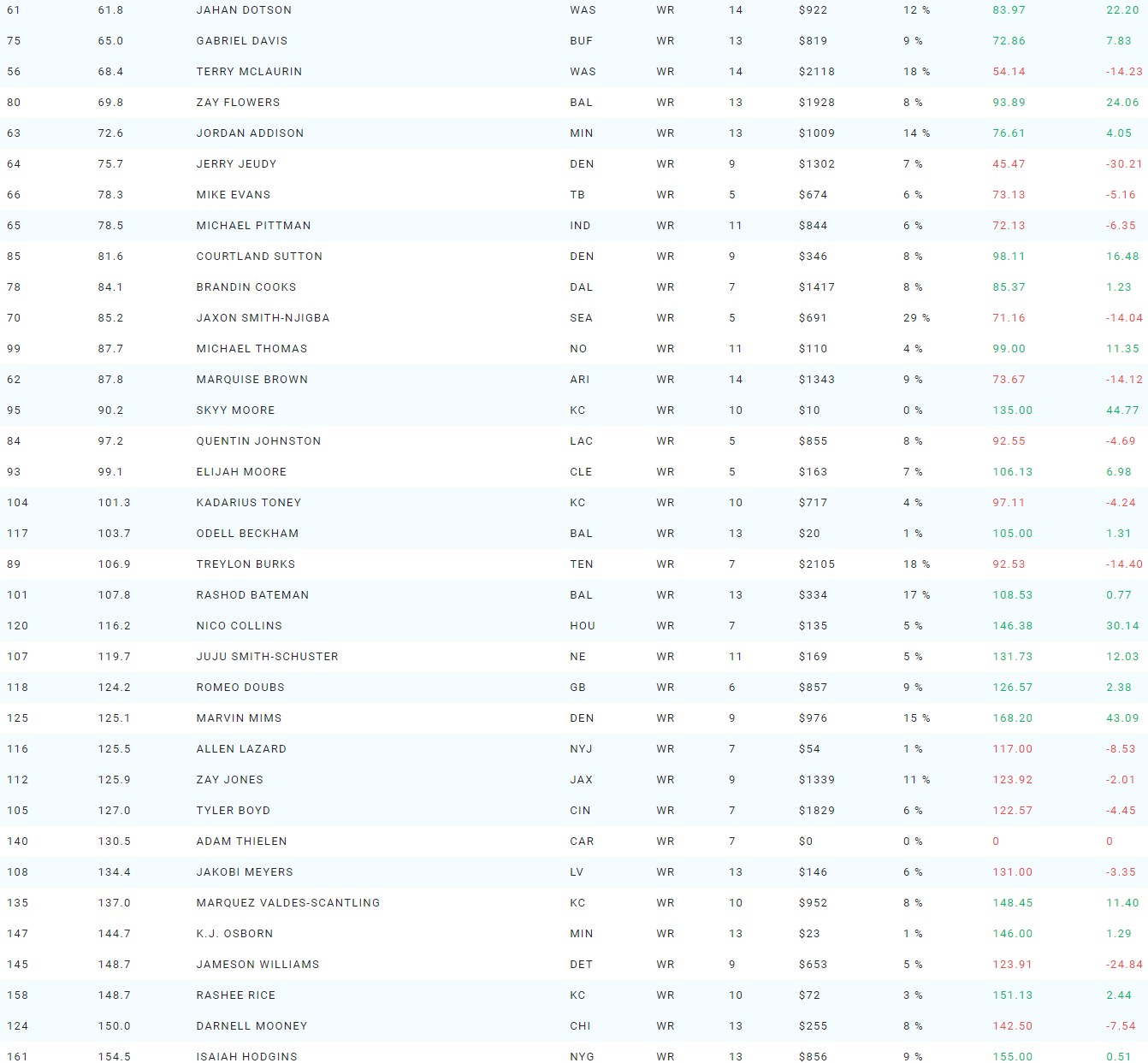
If I misplayed the JAX WR room, you best believe I came correct on the SEA WR room. This is how you play a relatively consolidated WR room with multiple talented weapons:
- 2% DK Metcalf (ADP 29.8, my ADP value of 4.99)
- 15% Tyler Lockett (ADP 60.7, my ADP value of 8.42)
- 29% JSN (ADP 85.2, my ADP value of -14.04)
Yes please, thank you, come again. I’ll jam this in the middle every day and twice on Sundays. “But Sack, you didn’t get ADP value on JSN!” You’re right, he was a late faller with the wrist injury and I DID NOT GIVE A SHIT. Any time I was in a draft after the JSN fall and his ADP was earlier than my next available pick I was taking him. If you’ve hung out in the Spike Week discord channel for a while you may have seen my toy game example that I used to help facilitate some discussion about when we should be selecting players that we think are grossly mispriced by the market. If you’re not familiar with what I’m talking about, I think it’s a valuable enough thought exercise that I’ll repeat it here.
A toy game is a simplified version of a game that we can use to understand the game theory on a deeper level. Best ball is a wildly complex game, and so using toy games to look at individual concepts of the game can be very informative. For this toy game, I find it easier to conceptualize if we remove fantasy football from it, so for now we are rare coin collectors.
Pretend you and I have been given 10 coins to choose from. We will take turns choosing coins one at a time. The value of the coins is not expressly given, we must individually evaluate the coins. The game is to maximize the value of the coins we select. The value of the coins will be revealed after we have finished selecting them. What process do you use to maximize the value of your coins?
If you don’t know anything about coins, you might do some research to try and estimate the values of the coins we have to choose from. Let’s add a wrinkle to our game.
We are given a coin collector’s almanac that we believe is partially accurate in valuing the coins. How does this change your process?
I know you’re probably tired of thinking about coins, but just bear with me for one more part and I’ll get to my point about JSN.
You have a high level of confidence that one of the coins is particularly rare and valuable. The coin’s value is not accurately reflected in the almanac. How do you decide when to take the rare coin?
In this toy game the coin collector’s almanac is ADP and JSN is the rare coin. Where you take him depends on how valuable you think he is relative to what you believe your opponents think of him, as well as the differential in his value relative to other players you would be able to select around him. In our coin game, pretend one coin is worth $10,000,000 and all the other coins have values under $1. It’s very clear we should just select the rare coin first, since we would win the game no matter what. We can let our opponent take all 9 remaining coins; it still won’t matter. If the values of all of the coins are much closer, and we can’t just outright win the game by selecting the rare coin, then it makes sense to wait as long as possible to take the rare coin, but it would be a fatal mistake to allow our opponent to get the coin especially if we were selecting coins of lesser value simply because the almanac had them valued in a way we were confident was not correct.
While we’re doing this game theory tangent, I think this is a good point to discuss week 17 game stacking, and how we can gain an additional advantage on the field by thinking one step farther than our opponents. Thanks to the DraftIQ tool, I’m able to analyze the frequency with which my opponents are game stacking specific week 17 matchups. Here’s the data for what opponents in my drafts for the $10 Milly Maker tournament were doing:
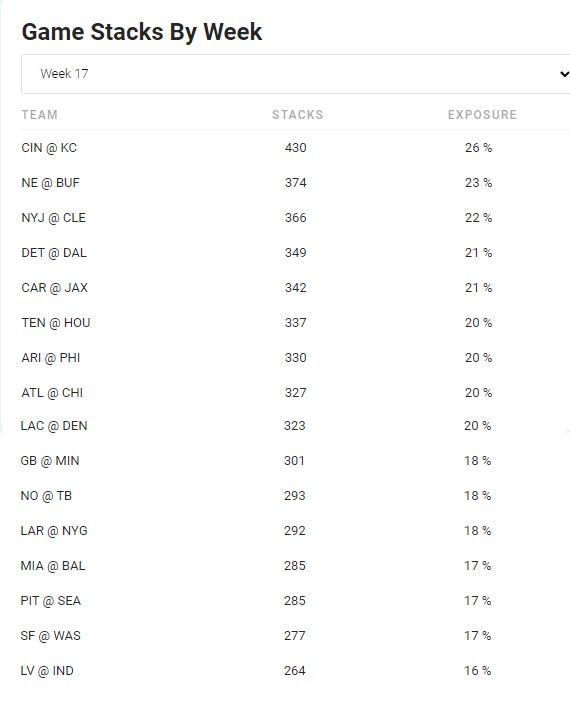
No surprise, the opponents that are concerned with stacking week 17 are privy to the KC v CIN game, as well as the DAL v DET game. Those are two of the prime games to target based on look ahead totals and the elite fantasy weapons available in both of those games. If you’re familiar with DFS, you know that it can be valuable to be on a game that the field is not.
In my Best Ball Tournaments and Roster Construction Combinatorics article I described a best ball team as occupying space. We can think of these most commonly stacked games as being a slightly more crowded space than the less commonly stacked games. The way I want to play week 17 is mostly as an added boost to the players I was already wanting to select for my specific roster construction. When I am using week 17 as a tie breaker though, I’m even more excited if I get to have a piece of a potentially underrepresented game, especially if it’s one where I can see a path to a shoot out. Here’s my week 17 game stack exposures for comparison:
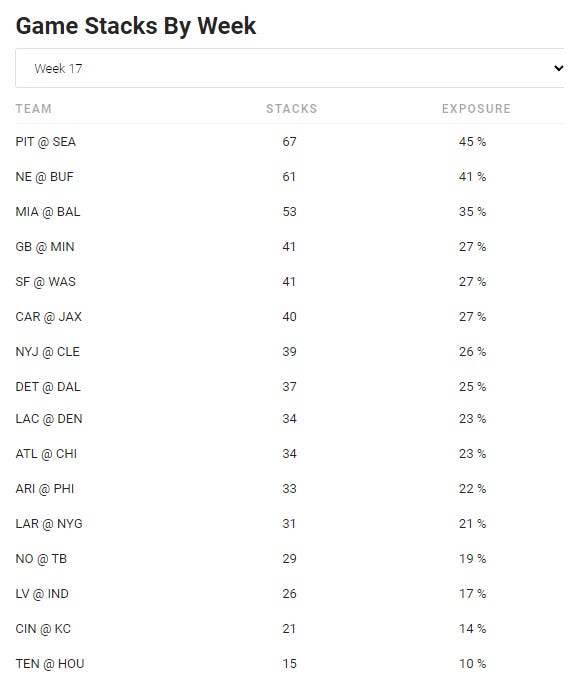
I’m nearly triple the field on SEA v PIT, more than double the field on BAL v MIA, and 1.5x the field on MIN v GB. I also stacked KC v CIN and HOU v TEN about half as frequently as the field did. These numbers shouldn’t be compared apples to apples though, as I’m certainly game stacking week 17 at a higher rate than the field. The point stands, though, that if I show up to the over 1,000 person final in the DraftKings $10 Milly Maker, I’ve positioned myself in a way where I’m potentially competing with less teams in the event that my most common game stacks go off. You might be thinking “Sack, there’s so much variance in these tournaments. How do you know what the ownership in the finals is going to look like?” I don’t. What I do know is an approximation of the base rate that these combinations occur at from my observation of the field via DraftIQ, and any variance will only amplify or dampen these frequencies. We don’t have perfect information, but we should try to make the best decisions we can with the information available.
We will now return to our regularly scheduled programming and dive back in to my player exposures. Dovetailing from my JSN exposure, I’d like to touch on the other first round (in the 2023 NFL draft) rookie WRs that fell into this range of the draft:
- 8% Zay Flowers (ADP 69.8, my ADP value of 24.06, lots of my shares coming on high stakes teams)
- 14% Jordan Addison (ADP 72.6, my ADP value of 4.05)
- 8% Quentin Johnston (ADP 97.2, my ADP value of -4.69)
My favorite WR of this cohort was Jordan Addison. Not only did I think he was the most talented of the three (I only had him behind JSN in this class), but we’ve seen what having the best WR in the NFL across from you can do for rookie production (see Juju Smith-Schuster).
I liked Zay Flowers, but not enough to chase him up the draft board. I was substantially overweight early in the draft season, but all my high stakes action on him combined with his rising price made me happy to pass on him later in the draft season and sit comfortably with my 8% at a great value.
I hated Quentin Johnston. I thought he was a terrible prospect. He flashed all kinds of N’Keal Harry warning signs to me. I am fairly certain his draft stock got elevated due to vividness bias, with NFL scouting departments seeing more of him due to TCU’s National Championship run, along with him being one of the only big bodied WRs in this draft class. My pre-NFL draft hot take was that Cedric Tillman would be the best big bodied WR to come out of this class, and while I like Tillman, it was more a statement of how low I was on Johnston. The reason I’m belaboring this point is that I had a lightbulb moment during this offseason, when I was discussing why I was out on Johnston with Pat Kerrane. Pat’s point was that I might not be wrong about all the red flags I was picking up with Johnston, but that:
- I don’t know ball (he’s right)
- All that means is Quentin Johnston has a wide range of outcomes
He could bust spectacularly, but if all of these NFL scouts that thought so highly of him were right he could be an absolute smash, especially at his price. So I begrudgingly ate my vegetables and got to a field neutral 8% of Quentin Johnston, and I felt like it was a major growth moment for me as a best ball player. Having conviction is important in this game, because when you’re right it can pay off in a major way. But humility is just as important. Being willing to admit that we don’t know everything and acknowledging the entire range of outcomes instead of a very specific outcome is very important when playing games of chance. After all, aren’t we looking for wide ranges of outcomes to win these massive tournaments?
Another rookie WR a little lower in ADP was Rashee Rice. After week 1 I’m afraid I may have misplayed this spot. I gave too much weight to my prior of “the Chiefs offense is very complex, rookie WRs typically get slow starts in it,” and not enough weight to my prior of “all of these WRs suck, the competition isn’t fierce for targets, take shots on the guys who you aren’t sure they suck yet.” The way I ended up playing it was to be field neutral on MVS, slightly overweight on Richie James, and with a sprinkling of Toney (after he fell), Ross, and Rice.
The last WRs I’ll give a blurb to in this group are two fallers, in Bateman and Burks. I liked both of these profiles: talented, younger WRs who haven’t had substantial opportunity due to injury, but both had flashed in limited playing time. I had a decent amount of both of these WRs prior to their ADP falls (Burks due to his camp knee sprain and Bateman due to missing camp time with his foot recovery). I didn’t feel like the bet materially changed for either guy, so I bought the dip. If they hadn’t slid so much I likely wouldn’t have ended up with such a large position, but I certainly don’t regret the way I played it.
We’ve made it to our final WR exposure screen shots. In the 2nd image I only showed the players that I actually have exposure to, so you don’t have to see my 0% Racey McMath or Kalil Pimpleton.
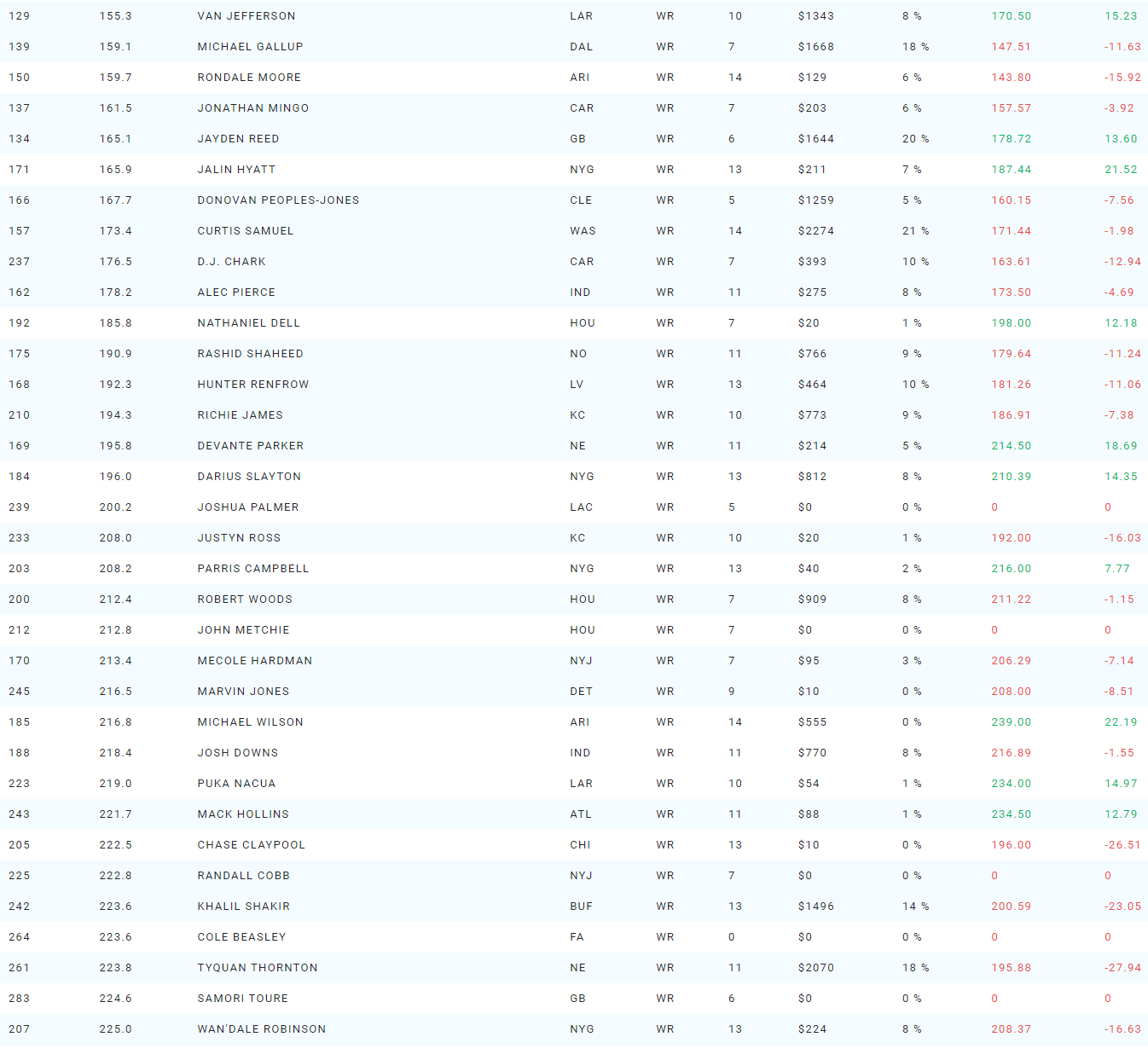

Let me get the biggest L’s out of the way first. 11% Corey Davis, my bad. I honestly thought he had a good chance to be the 3rd WR for the Jets and I had seen reports that the coaching staff really liked his effort when blocking. I figured the former 1st round WR may still have a little juice left (even though the advanced metrics said he was complete dust last season) and that the couple splash plays we saw from him last season may come a tiny bit more frequently with Aaron Rodgers at the helm. I envisioned crafty Rodgers, getting free plays with his hard counts ripping deep shots to savvy veteran Corey Davis who would know to go when those free plays occurred. Huge L here, I’d love to distribute that 11% to guys like Puka Nacua and Kendrick Bourne.
18% Tyquan Thornton, oof. He’s not dead yet, but it’s not looking great. Thankfully I did course-correct on this position once I got more information that he was looking less than stellar at camp, and I got on to the right answer of Kendrick Bourne. Unfortunately for me, I wasn’t able to get very much volume down in late August and early September, so I had already made my bed on Thornton. I don’t think the thesis was bad though; Bourne already showed how the thesis on Tyquan could have played out. The target competition is weak in New England, and Tyquan was a highly drafted prospect. The problem is that the Patriots fucking suck at evaluating WR talent, and I probably shouldn’t have trusted that Tyquan would be a hit for them.
14% Khalil Shakir, same song, different chorus. It looks like Harty is the late round Bills WR dart throw of the two that I should have preferred (at least after week 1). I actually liked Shakir a bit as a prospect, and thought he was somewhat promising last season, although the information I got later in the offseason was that the Bills did not share my sentiment. Eventually I course-corrected to Harty, but this is definitely a spot where I wish I would have randomized more.
Now that we’ve got the yuckiest bits of these late WR exposures behind us, let’s take a look at some of the larger exposures I have in this range.
Curtis Samuel at 21% had a lot of factors working for him, which is how I ended up more than double the field on him. Not only did I feel fairly confident in his season long projection relative to the other WR options being drafted near him, he also opened up the late Sam Howell stacking option if I still needed a QB, and he was often a week 17 bring back I would tack on to Elijah Mitchell teams.
Jayden Reed at 20% was a rookie that I loved. He displayed dynamism in college in the return game, which is a trait I highly value in evaluating rookie prospects. Multiple analysts whose opinions I trust also liked Reed, which confirmed my bias towards him. I also liked his situation, as I am not sold that Christian Watson is the locked-in #1 in that offense, and the cost on Reed was so cheap I always felt good about taking a shot on him. Last, he had a week 17 matchup against the Vikings that I really liked to target as a game stack.
Rashid Shaheed was a mistake. I was on him very early, with 20% exposure in Underdog’s Big Board contest. I ended up with nearly 20% on Underdog on the main 2023 NFL best ball slate as well. So why did I only get 9% on DraftKings where he went cheaper because of a ‘Questionable’ tag for much of the summer? Honestly I think I did the thing that I mentioned earlier of “passing on the best pick for the sake of portfolio risk mitigation.” I look at my player exposures not only on a site by site level, but from an entire portfolio level, and this was a spot where I somehow talked myself out of doubling down on the bet. This was honestly one of the spots I’m most frustrated with myself on, because I knew better. I really liked the player, I should have loved the price, and 20% of a player going this late is really not even that much. I’m honestly frustrated enough that I am going to take a break from writing this article and come back after some self flagellation.
Alright, I’m back and feeling much better after watching Jordan Addison post an impressive stat line against the Eagles on Thursday Night Football. Let’s talk about the Puka Nacua sized elephant in the room. I clearly got to deeper WRs on the Rams depth chart with my 5% Tutu Atwell, why didn’t I end up with more Puka? Puka was a poorly graded prospect with 5th round draft capital, not the type of profile I would expect to break out at a high frequency. What I failed to properly account for though is:
- The drum beat on Puka through OTAs and training camp
- The lack of talent on the WR depth chart outside of Kupp
- Rookies are good bets in general because their ranges of outcomes are the widest, just yolo a couple 20th round picks on Puka Nacua (after all, you didn’t hesitate to do so on guys like Cedric Tillman)
To be fair to myself, I really don’t think I was that far off in how I played this spot. I wrote a note to myself in my “Best Ball Strategy Things to Remember” google doc after last season that read “Diversify dart throws that you’re stacking from a team (TDP vs. Jeff Wilson, Olamidae Zacheus vs. Cordarelle Patterson in 2021, etc.).” So I at least started to take my own advice, by grabbing a couple shares of Puka, but next season I’m going to utilize even more randomization in my process of selecting these late dart throw players. Something like, “I need a Rams player as a bring back, I have no idea if Tutu or Puka is a better pick, I’ll randomize at a 50/50 frequency.” Or, if I have evidence to believe one player is more likely than the other to become relevant, I might weight slightly more in their favor. In the Tutu vs. Puka situation though, I did believe Tutu was more likely to be relevant, but not 5% vs. 1% levels of confidence.
As I stand back and look at some of the places where I feel I wish I had done something differently, a lot of it comes down to the late information advantages from drafting at the very end of August and beginning of September. That was the period when we had the highest confidence in players like Kyren, Puka, Kendrick Bourne, Josh Kelley, etc. There wasn’t much I could do differently this season, because I simply didn’t have the time to draft as much volume during that window. I’m making a note to myself right now to not let my wife schedule any vacations for the end of draft season next year (she’s going to love that).
We’ve almost made it to the end of my DraftKings exposures, so let’s power through to the way I played the TE position:
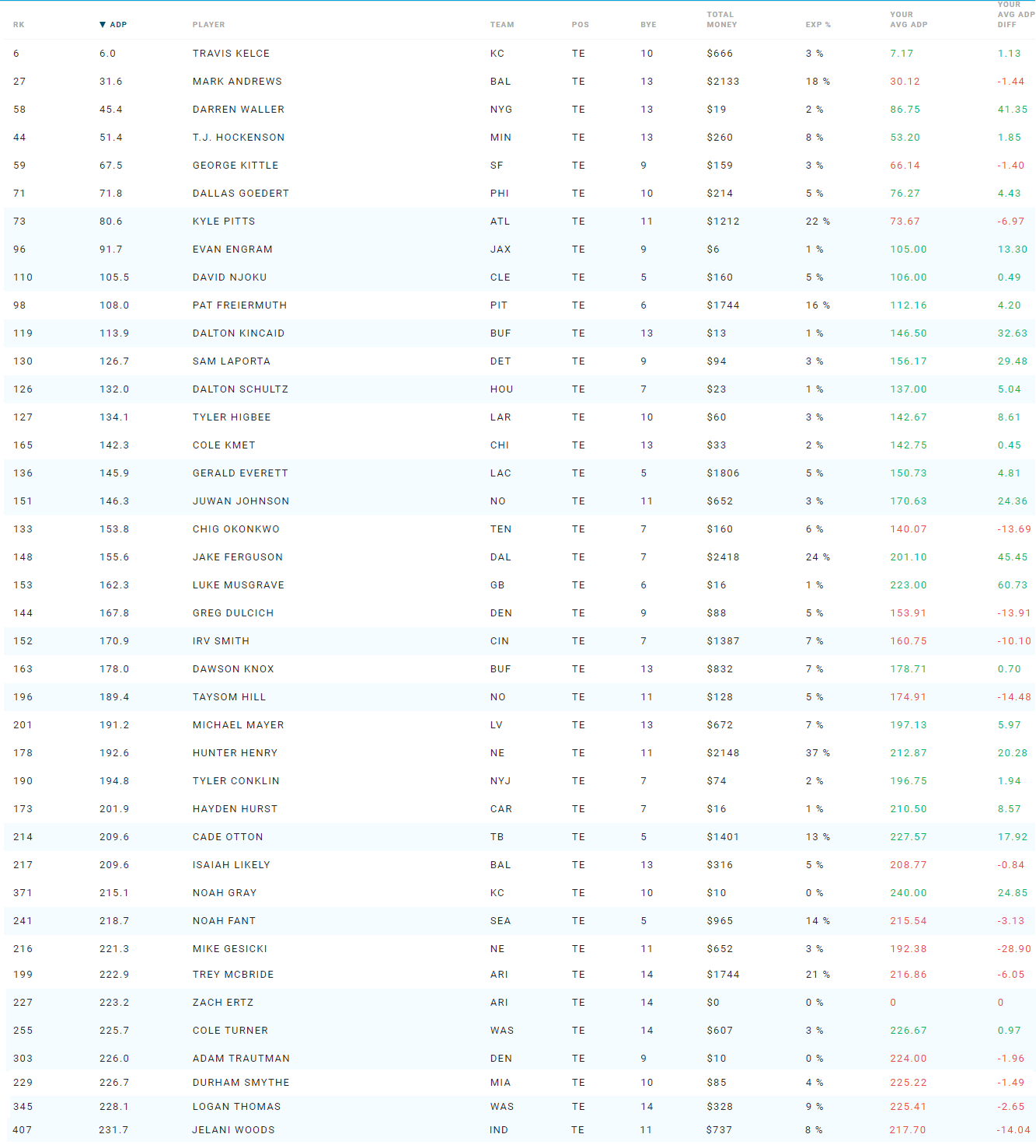
In general the way I attacked TE on DK was to often forego the earliest elite TEs (until I course-corrected on Andrews) because I felt like Pitts was such an extreme value at his price, especially in full PPR scoring. In general if I missed on getting one of the elite TEs I’d push the position to the last few rounds, because I felt confident the market was very incorrect in the TE pricing. I was willing to put substantial bets down on Hunter Henry and Jake Ferguson being the starting TEs on their teams. I liked them each for slightly different reasons, Henry due to his talent profile (he’s a legitimately good TE and has posted impressive numbers in the past) and lack of target competition, Ferguson for the TD potential in an offense I thought would continue to be very good that has historically involved the TE pretty heavily. The market eventually caught up with me on these assessments, which led to some nice CLV on both players (but CLV is almost entirely meaningless this late in the draft, although Ferguson did rise enough to make it slightly beneficial).
I don’t have a ton to say about TE other than the position is so highly variant and in general has such a low floor that I think we should only be selecting TEs in the early and middle rounds if we think they have significant spike week potential. Not just in that they can generate a single spike week, lots of the late round TEs can do that too off the backs of TDs, but that they could consistently generate spike weeks like we’ve seen with the elite TEs. It’s that spike week frequency that I’m chasing with the TEs that cost more draft capital, because that is what can provide a substantial advantage in the playoff weeks.
A brief summary of some of my overweight late round TE positions and what got me to them:
- Cade Otton – extremely clear role, should be the dude
- Noah Fant – incredible talent, has flashed big play potential, a nice bet for a flop lag break out
- Trey McBride – exciting prospect (good athlete with a 99% college dominator rating, early breakout age, and good college YPR), I didn’t expect Zach Ertz to have such a quick ACL recovery timeline, and I certainly didn’t expect the Cardinals to use Ertz so heavily over their athletic young TE in what looks to be a lost season
Before I wrap up the DraftKings section of my Portfolio Postmortem series, I want to show off another feature of DraftIQ that I found extremely helpful in managing my portfolio. Being able to review your individual QB stacks is a great way to check in and make sure you’re not going on auto pilot too much in your drafts and repeating the same combos more than you would like. Here’s an example of all my Tua stacks:
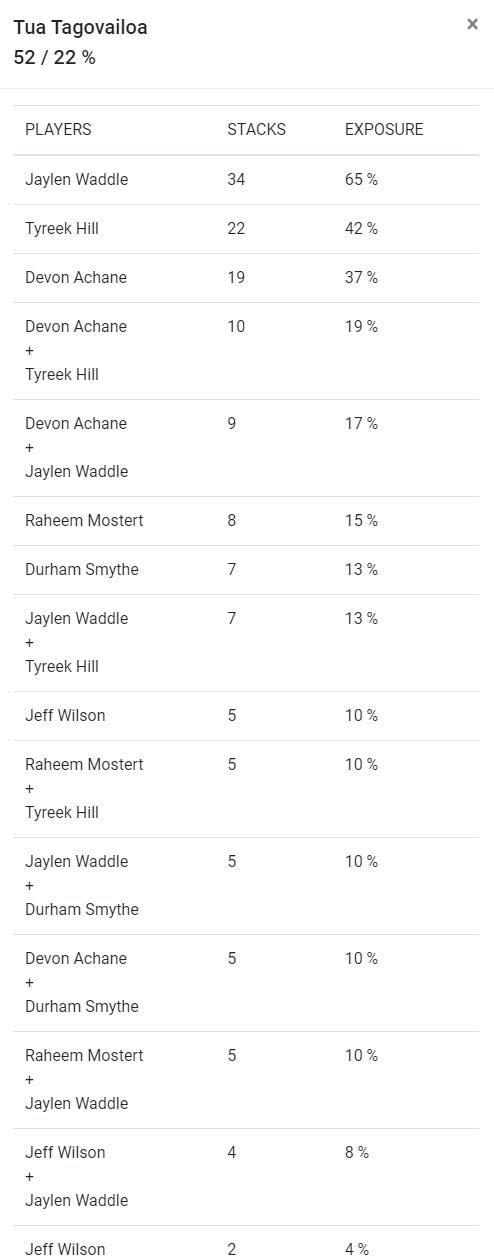
I really valued stacking RBs in a team stack, especially those that had inverse draft capital relationships to the passing side of the stack. I also made sure I had a good mix of the different stack combinations, as I loved the offense but I am not confident enough in a specific outcome to want to hammer one specific combo over others. On the same page of DraftIQ I can do the same type of portfolio analysis with respect to specific week 17 matchups (I showed the game by game overview earlier in this article). By selecting a specific game I can see all of the game stack combinations as well, which I also think is important to take a diversified approach. Here’s a sample for the BAL v MIA game:
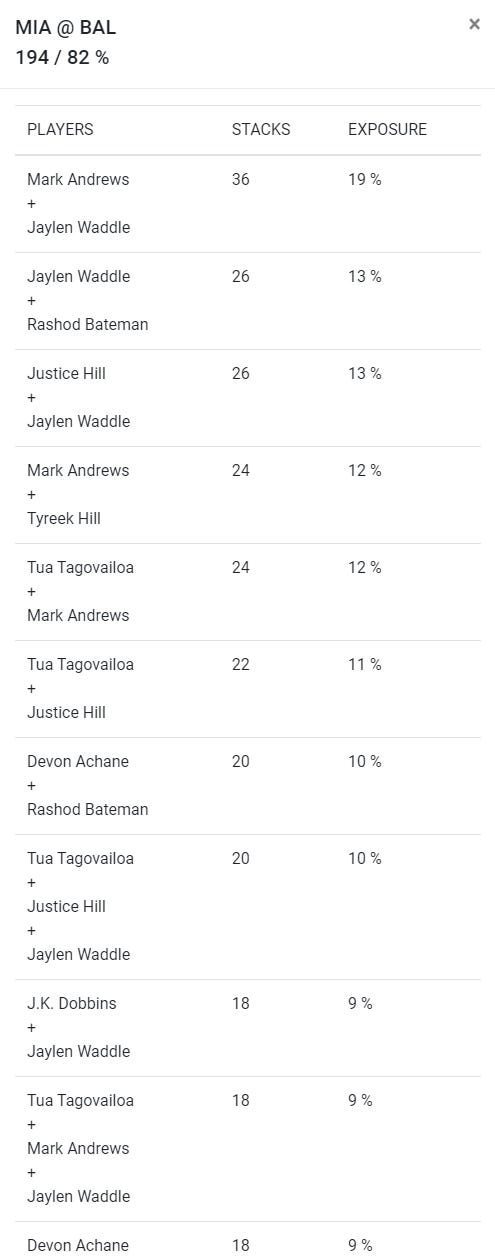
I won’t post the exhaustive list of combos, because it would take about 10 images to display them all, but you can see the effectiveness of this tool in doing some more granular portfolio review. Before we wrap up, I’ll share some of my craziest teams when measured by effective draft capital. If you didn’t read the Spike Week Draft Capital Model Explained article, a quick summary of effective draft capital is that it can be seen as the draft capital advantage gained over the average team in the tournament. So without further ado, here’s some wild ones the kind drafters on DraftKings let me get away with:
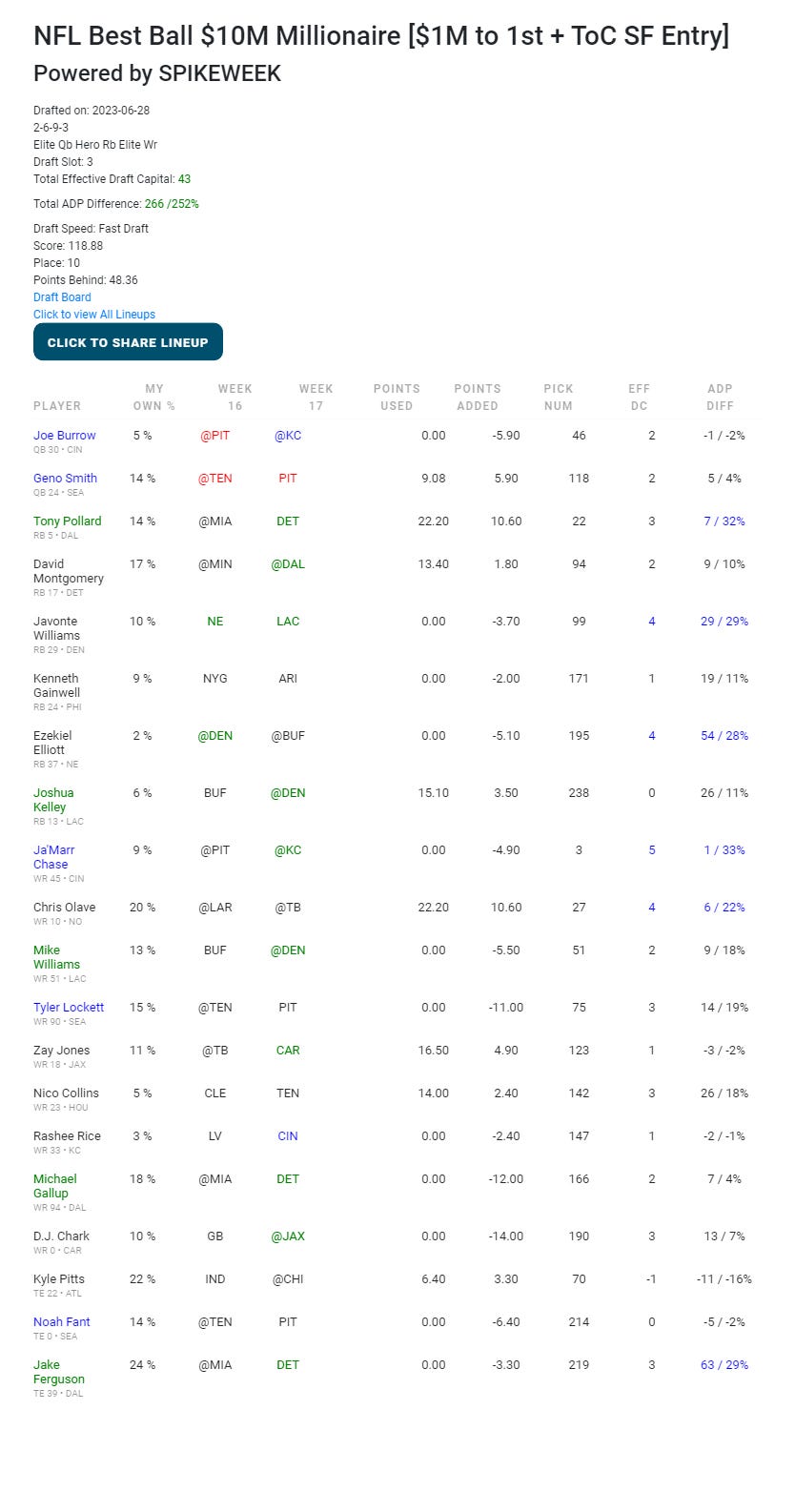
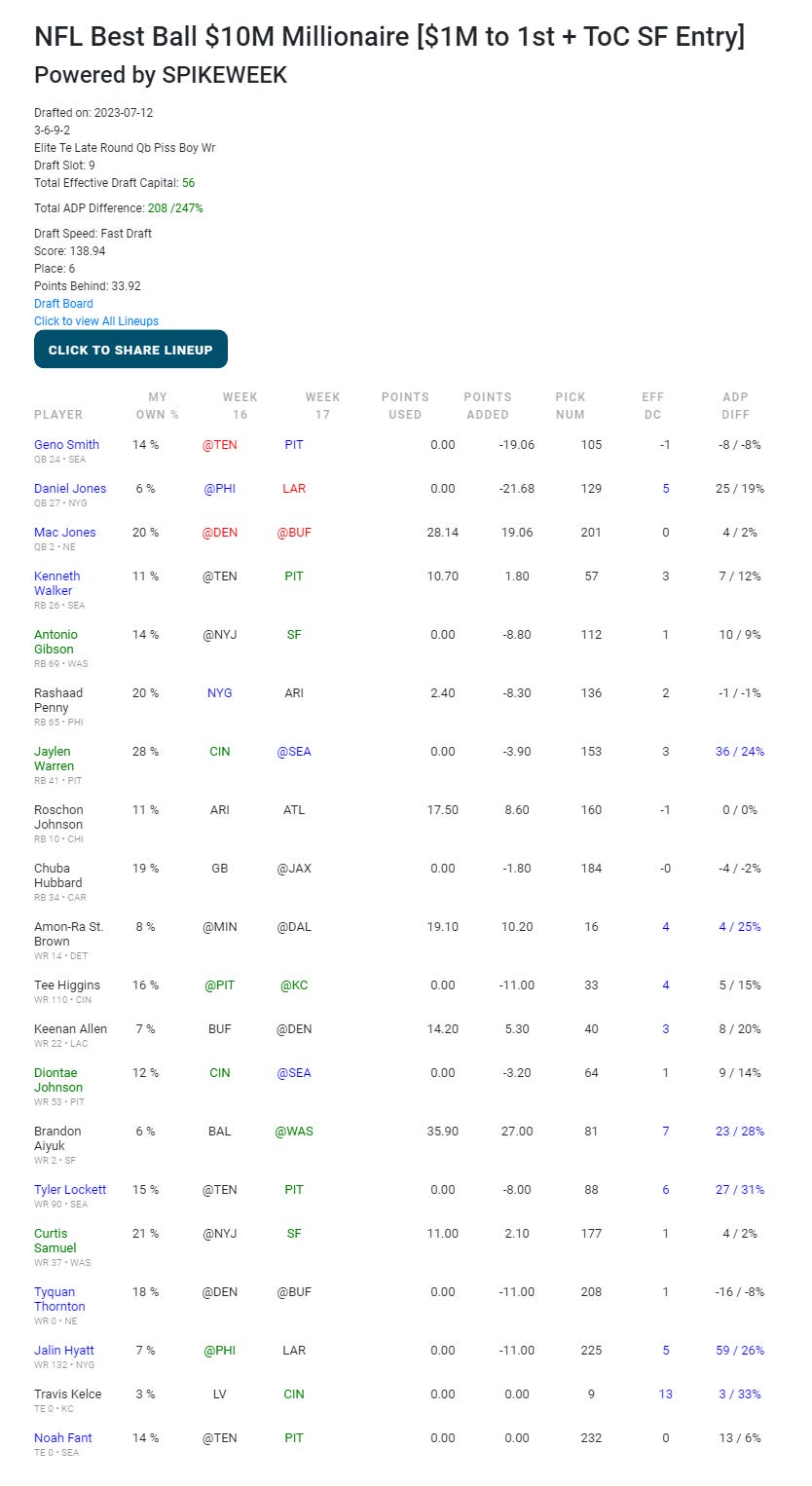
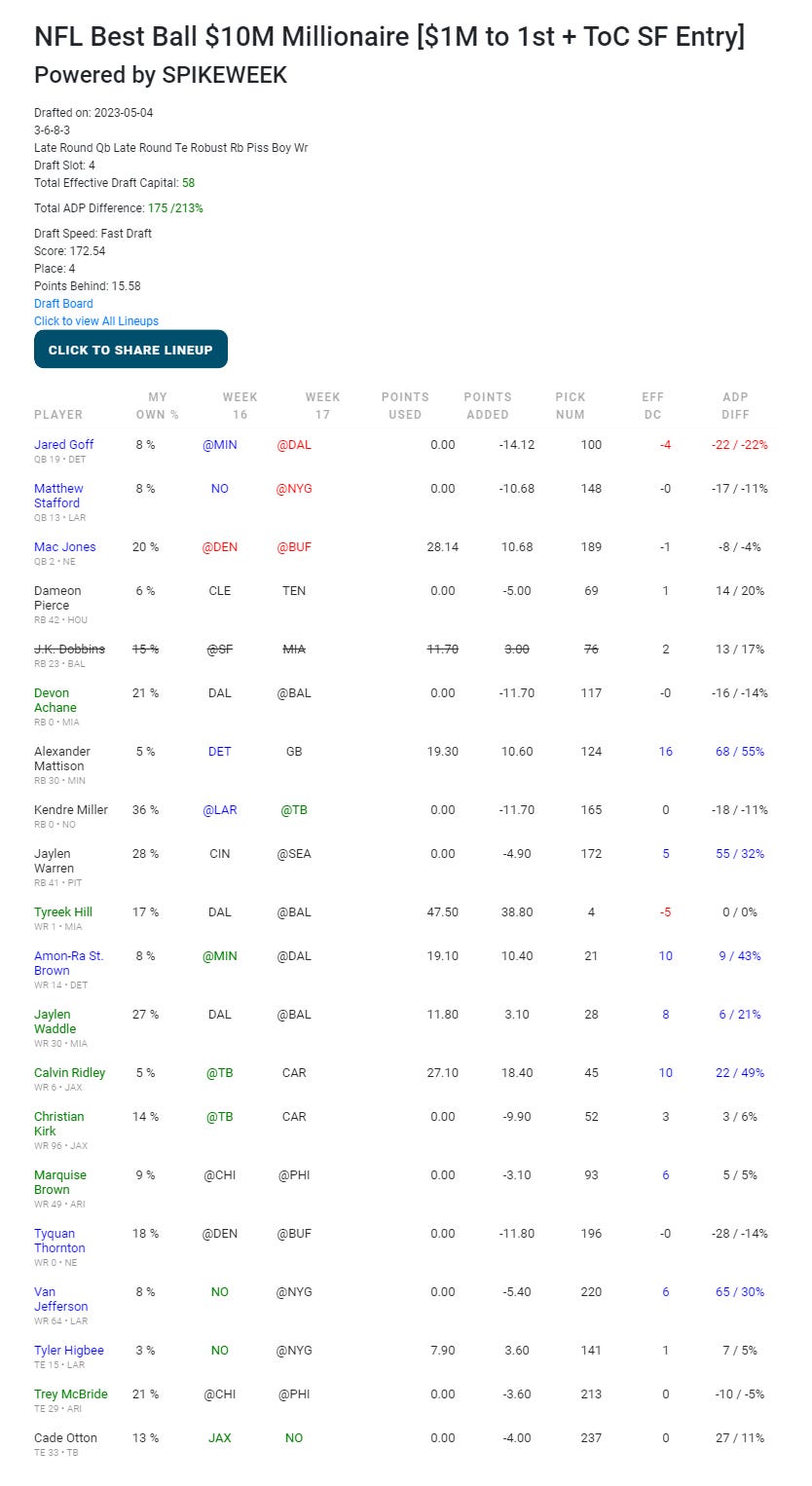
If you made it all the way through this article, please accept a genuine thank you for reading. I really hope it was not only an enjoyable read, but that you took something away that makes you a better drafter in the future. You can always find me in the Spike Week discord channel if you want to chat, or even just tell me that my article sucked. Until next time, Sack out.




